Grow Herbs Indoors: Herbs that Thrive Inside
This post may contain affiliate links, which means that I may receive a commission if you make a purchase using these links. As an Amazon Associate I earn from qualifying purchases.
You don’t need a garden to grow fresh herbs. Growing herbs indoors makes it easy to snip fresh foliage to flavor meals whenever you need them. Here are 14 herbs that will grow indoors, plus tips to get your indoor herb garden started.
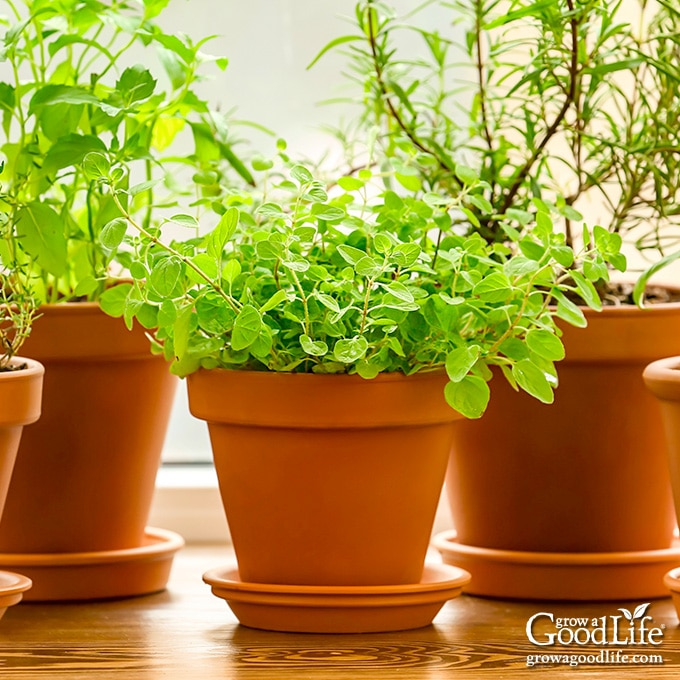
Fresh herbs invigorate every meal and just make everything taste good. During the growing season, I love stepping into my garden and harvesting herbs by the handful as needed for cooking.
If you do grow herbs in your garden, fall is a great time to think about starting an indoor herb garden so you can continue to enjoy the fresh flavor all winter long. Even if you don’t have outdoor gardening space, there are plenty of herbs that you can grow indoors successfully with just a sunny windowsill.
Tips for Growing an Indoor Herb Garden
Probably the most difficult thing, is deciding which herbs to grow. Think about the meals you cook and the herbs you find yourself reaching for time and again. Also consider the herbs you would use more in cooking if you had them easily on hand.
The list at the end of this article breaks down the easiest herbs to grow indoors and their needs to help you decide. Look it over and think about which herbs you want to grow, and check out these tips:
Evaluate Your Environment
Once you have an idea of which herbs you would like to grow, evaluate your indoor growing environment and narrow down your selection.
Herbs love plenty of light: Most herbs need at least 6 hours of sunlight each day and will grow healthy in a bright, south-facing window. Other herbs can tolerate about 4 hours of sunlight and will grow in an east- or west-facing window.
South-facing windows have the brightest light and most hours of sun, while east- and west-facing windows receive sun for part of the day in the morning or afternoon. Summer’s sun offers longer hours of intense light. This may be too much for some herbs. Consider growing herbs in an east or west-facing window instead for the summer.
Winter sun isn’t as strong or long. Locate your indoor herb garden in a sunny south-facing window for winter so it can get the most light. If you don’t have a sunny south facing window, use a grow light or fluorescent light to supplement lighting.
Herbs grow best with warmth: Most herbs thrive at temperatures between 60-75˚F.
Winter night temperatures can be cold and drafty near windows that are not insulated. Herbs that are sensitive to chilly temperatures are basil, lemon balm, and rosemary. If you grow these herbs, consider locating them on a plant stand away from the window, or pull the plants out of the window at night.
These cool weather herbs do well indoors even in winter: chervil, chives, cilantro, dill, lemon balm, oregano, parsley, sage, sweet bay, and thyme. Growth will slow down when the temperatures are cooler.
You will need to experiment to see what works for your indoor environment. Don’t be afraid to try growing your herbs in different areas. A warm sunny window in the middle of summer may be too hot for most herbs, while a cool winter window too cold for some. If your herb plant looks unhappy, move it to a different area and see if it perks up.
Find Attractive Containers
Herbs grow at varied rates and have unique requirements for sun, water, fertilizer, and harvesting. Growing each herb in a separate container makes it easy to care for its individual needs. You may need to move your herbs from one window to another, or water it more than the others. Having each plant in its own container gives you more flexibility.
Your containers should be at least 6-inches diameter and 6-inches inches deep. If you are growing from seeds, you can start out smaller, and then pot up as your plants grow.
Basil and parsley have very deep roots, so a taller container will let them stretch out a bit. Try to aim for at least 12-inches deep.
Drainage is very important. Herbs don’t do well growing in soggy soil. There should be adequate drainage holes in the bottom of your pot so extra water can drain out. Be sure to use a saucer or tray to protect your windowsill from moisture.
Herbs that Grow Well Together
If you do want to grow herbs together in a larger planter, group them together based on their growing needs, such as sunlight requirements, temperature, moisture, and rate of growth. Be sure to give them plenty of space to grow and harvest frequently to keep the plants compact.
- Slow Growing Herbs: Chives, lemon balm, mint, oregano, sage, and thyme can grow together in the same large container. Plant in a large, deep container because most of these will grow very tall.
- Moisture Loving Herbs: Plants that like evenly damp soil include basil, cilantro, mint, and parsley will grow well together in the same container.
- Herbs that Prefer Dry Soil: These herbs prefer growing in bright light, warm temperatures, and in dry well draining soil: bay laurel, chives, oregano, rosemary, sage, sweet marjoram, and thyme.
- Cold-Hardy Herbs: If you are growing herbs indoors during winter on a chilly windowsill, these cold tolerant herbs will put up with decreased sunlight and temperature changes: chervil, chives, mint, oregano, parsley, sage, and thyme.
Use the Right Potting Mix
Choose a good organic soilless potting mix for your windowsill herb garden. A balance of good drainage and moderate moisture retention is the goal.
A good potting mix for indoor container plants is light, fluffy, and drains well to promote healthy root growth. If the potting mix is too soggy, the herb may struggle.
Avoid using soil from your garden because it will be too dense for containers and may contain pests and disease.
Look for an all-purpose soilless potting mix that contains peat moss (or coconut coir), vermiculite, and perlite. You can mix your own basic soilless potting mix with this simple formula: 4 parts sphagnum peat moss or coconut coir, 1 part finished compost, 1 part perlite, 1 part vermiculite.
Some indoor herbs need a more sandy soil mix. To achieve this, mix equal parts all-purpose potting mix and sharp sand. Or use cactus-potting mix.
Don’t Overcrowd the Plants
It may be tempting to heavily line your windowsills with multiple pots of herbs, but your plants need full access to sunlight and good air circulation around the foliage to keep them healthy.
Plants do breath in their own way. They absorb oxygen from the air and release carbon dioxide. Plants also give off water vapor in order to keep themselves cool. Good air circulation helps excess moisture evaporate, reducing the danger of fungal diseases.
Ways to Start an Indoor Herb Garden
If you start your indoor herb garden in fall, and want to harvest herbs right away, begin with established plants so they will continue to grow indoors over winter and produce quicker.
I like starting with plants potted up from the garden, purchased from a nursery or garden center, or rooted from plant cuttings. Growing from seeds requires time before the herbs can be harvested and used.
Purchase Herb Plants
The easiest and fastest way to start your windowsill herb garden is by purchasing plants and repotting them into your containers. You can find herb starts at your local nursery and even your local grocery store.
Grow from Stem Cuttings
If you have an outside herb garden, you can snip sprouts, root them in water, and plant in containers.
Propagating herbs from cuttings is a quick way to establish a plant. Cut a 5-inch stem, strip off the bottom few inches of leaves, place stem in water to root, plant into pots once roots develop, and water frequently until established. Then water as needed.
The advantage of mastering this skill is it works with so many other plants too! Try rooting basil, lemon balm, mint, oregano, rosemary, sage, sweet bay, and thyme using the same process described in the article below:
Divisions from Your Garden
You can dig, divide, and pot up some herbs from established garden plants. The best herbs to grow from divisions are chives, lemon balm, mint, oregano, sweet marjoram, and thyme.
If you have houseplants, it is a good idea to quarantine any plants brought in from your garden for a while to be sure there are no hitchhikers such as pests or disease. Leave these in a separate room for several weeks to be sure there are no surprises.
Start Herbs from Seed
It takes much longer to grow herbs from seed. However, annual herbs, such as basil, cilantro, dill, and parsley can be easily started from seeds indoors. If you enjoy the nurturing process of sowing and cultivating plants, then starting herbs from seeds is a great way to raise a number of plants.
Use an Herb Garden Kit
Herb garden kits come with all the materials you need to start herbs from seeds, including pots, herb seeds, and instructions. These are great way to get started with your herb garden. The only downside is the kit may contain herbs you don’t want. Also, the containers tend to be small, so you will need to repot into larger containers as the plants grow.
How to Plant an Indoor Herb Garden
Step 1: Gather your supplies
You’ll need:
- 6- 12-inch pots and saucers – one for each herb
- All-purpose soilless potting mix
- Horticultural sand (optional to help increase aeration and drainage)
- Herb plants or seeds
- Dishpan or other large container for mixing and wetting the potting mix before using
- Liquid organic plant food
Step 2: Plant or Pot-up the Herbs
If growing from seeds, follow the instructions for sowing seeds on the back of your seed package, and pot up the plants when they are about 4-inches high.
If you are starting with established plants, you will want to repot your herbs into containers.
Add potting mix to a large container and moisten it with water. You want the mix to be damp, but not soggy. Let it soak in for at least 30 minutes.
While the potting mix is soaking, water your herb starts well to reduce stress and help them slip out of their original containers more easily.
Fill the bottom of your new pots with damp potting mix.
Remove the herbs from their containers. Loosen the root ball with your fingers, and place the herb plants into the pots about 1/2-inch deeper than they grew before. Add or remove potting mix if needed to adjust.
Hold the foliage upright, and fill in the sides of the container with the damp potting mix. Use your fingers to work the potting mix down the sides of the pot. Press gently to eliminate air pockets without compacting the soil.
Water well and let the excess moisture drain out the bottom holes. Keep pots evenly moist until you see signs of new growth, and then water when soil surface feels dry.
Step 3: Give them Light
Place newly re-potted herbs in indirect sunlight until they start showing new growth, and then move them to a bright, south-facing window.
How to Care for Herbs that Grow Inside
After setting up your indoor herb garden, all you need to do is find a sunny spot, water, and snip fresh herbs when needed. Here are tips to care for your herbs:
Water your herbs when the soil feels dry on the surface
Let the soil dry out a bit in between waterings. To test, stick your finger into the soil. Water if the soil is dry one inch below the top.
Place your containers in the sink and water well with room temperature water. Pour the water slowly to allow the soil to absorb the moisture and let the excess water drain out the bottom of the pots.
Return the herb container to the windowsill. Make sure to use a saucer to prevent water damage to your windowsill. Remove extra water if it continues to drain into the saucer.
Herbs slow their growth in the winter, so they may not need to be watered as much as in the summer.
Fertilize to provide nutrients
All-purpose soilless potting mixes are a great growing medium for indoor herb plants, but some may not contain any nutrients, or if they do it will only last for a short period.
Fertilizer can be used to give the herbs a boost to help them grow indoors. Feed your herbs with liquid seaweed or add a scoop of finished compost in late winter as daylight begins to increase.
Feed your herbs monthly during the summer with a liquid fish emulsion or other organic plant food. Follow the directions on the package for indoor plants. Over-feeding can cause the leaves to lose flavor so don’t be too generous.
Rotate the containers for even growth
Plants will lean towards the sunlight. Give your plants a quarter turn every time you water so all sides can get some sun.
Harvest and prune
Wait until your herbs become established before harvesting. Plants use their leaves to absorb light and grow, harvesting too early may stunt your herbs. Herbs should be at least 6 inches tall before snipping foliage.
Also only harvest less than 1/3 of the foliage at a time so you don’t stress the plant. Snip the older leaves from the outside of the plant and let the new growth continue producing fresh foliage.
Prune to keep the plants attractive and compact. Remove any flower buds that form. Once the herbs flower, their foliage takes on a bitter taste.
Repot when needed
If the roots are growing out of the holes in your container, it is time to repot into a larger container.
That’s it! You are on your way to an abundance of fresh herbs to flavor your meals.
14 Herbs for Your Indoor Herb Garden
I’ve experimented over the years with various ways to grow herbs indoors. Some do fine while others need more light and warmth than a kitchen windowsill provides. However, there are plenty of herbs that can be grown indoors successfully even during winter on a sunny windowsill. Here are my favorite herbs that thrive inside:
Basil
Italian Genovese Basil (Ocimum basilicum) is an annual herb that grows upright with broad, smooth, shiny green leaves. The flavor of basil blends well with tomato dishes as well as pesto. If you are a big fan of pesto, be sure to grow lots of basil so you’ll have plenty on hand to whip up a batch whenever you crave it.
Basil grows best in full sun and warmth, so find the sunniest spot for your plants and you will be rewarded with plenty of foliage. Basil is sensitive to cold, so keep the plants away from cool drafts and pull out of the windowsill in winter.
Your basil plants will produce for several weeks. Eventually, the stems get woody. To ensure a steady supply of basil, plant a new batch of seeds every few weeks. Or you can root cuttings in water, and then pot up in fresh potting mix once the roots develop.
Tips for Growing Basil Indoors:
- Sunlight: Full sun, at least 6 hours per day
- Room Temperature: Average temperature, between 60-75˚F. Avoid drafts
- Potting Mix: All-purpose soilless potting mix
- Watering: Once or twice a week when the soil surface feels dry. Basil prefers evenly moist, but not wet soil.
- How to Grow: Start from seed, plants, or cuttings. Basil has a robust root system. Plant in at least a 12-inch deep container so it can stretch out. Also see How to Grow Basil for additional information.
- Harvest: Once the plant is about four inches tall, begin harvesting by cutting stems just above a pair of leaves. The plant will grow new stems where the two leaves are. Keep the plants producing by pruning sprout tips and pinch off the flower heads as they form.
Chervil
Chervil (Anthriscus cerefolium), also known as French parsley is an annual herb with an anise-parsley flavor. It is often used in French cooking and is an essential ingredient in Béarnaise sauce. One of the four herbs used to make the traditional French fines herbes blend. Chervil pairs well with eggs, vegetables, poultry, and fish dishes.
Chervil is one of the easiest herbs to grow indoors because it likes cooler temperatures and doesn’t need as much sun as other herb plants do. It has a very short lifespan, only several weeks from seed to harvest, and then the plants begins to set flowers. To ensure a steady supply of chervil, plant a new batch of seeds every few weeks.
Tips for Growing Chervil Indoors:
- Sunlight: Full sun to partial shade, about 4-6 hours per day
- Room Temperature: Cooler temperatures, between 60-70˚F
- Potting Mix: All-purpose soilless potting mix
- Watering: Once or twice a week when the soil surface feels dry
- How to Grow: Start from seeds. Chervil seedlings do not transplant well. Chervil has a long taproot, so select a deep container to accommodate it. Chervil seeds need light to germinate. Sow seeds placing them on top of the soil and mist frequently.
- Harvest: Harvest by snipping the ferny foliage from the outside of the plant. Both the foliage and the stems are edible. Prune out the flower stalks as they grow.
Chives
If you grow only one herb indoors over winter, let it be chives. The mild onion or garlic flavor can be added to so many dishes from breakfast to dinner. Both common chives (Allium schoenoprasum) and garlic chives (Allium tuberosum) are great additions to your indoor herb garden. The spiky foliage and mild onion or garlic flavor compliments many recipes, including soups, scrambled eggs, salads, and sprinkled as a topping for baked potatoes, pizza, and chilies.
Tips for Growing Chives Indoors:
- Sunlight: Full sun to partial shade, about 4-6 hours per day
- Room Temperature: Average temperature, between 60-75˚F
- Potting Mix: All-purpose soilless potting mix
- Watering: Twice a week when soil surface feels dry
- How to Grow: Start from seed, plants, or divisions. Chives are perennial herbs, so you can plant them in your garden if they become too large to grow in containers. Common chives will come back every year in growing zones 3-10. Garlic chives in growing zones 5-10. Also see How to Grow Chives for additional growing information.
- Harvest: Once the plant is 6 inches tall, cut foliage as needed 2 inches above the soil. Harvest from the outside of the plant and allow the center to continue growing new leaves.
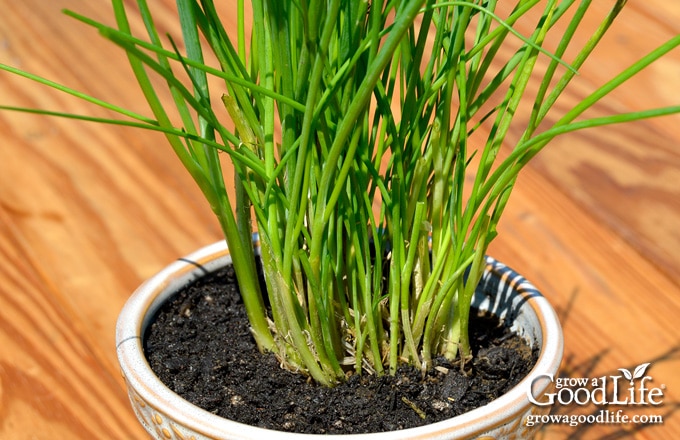
Cilantro
Cilantro / Coriander (Coriandrum sativum) is a cool season annual herb that grows and matures quickly. The leaves are called cilantro, and the mature dried seeds are called coriander. The foliage is also known as Chinese parsley. The bright lemony flavor of the leafy green foliage pairs well with Asian and Southwestern foods. The crushed coriander seeds adds a mild earthy lemony flavor to soups and stews.
Tips for Growing Cilantro Indoors:
- Sunlight: Full sun, at least 6 hours per day
- Room Temperature: Cooler temperatures, between 60-70˚F
- Potting Mix: All-purpose soilless potting mix
- Watering: Water young plants frequently until they mature. Keep young plants evenly moist or they may bolt, or set seed quickly. Water mature plants twice a week when soil surface feels dry.
- How to Grow: Start from seeds. Cilantro doesn’t like to be transplanted and may bolt, or go to seed prematurely if the roots are disturbed. Sow the seeds every 3 weeks for a continued harvest. The foliage turns bitter once the flower stalks form. You can let the seeds mature and dry on the plant and use them to grow more coriander, or ground and used in cooking.
- Harvest: Once the plant is at least 6-inches high, begin harvesting by cutting the larger outer leaves as needed. The plant will continue to grow for several more weeks from the center of the plant.
Dill weed
Dill (Anethum graveolens) is an annual herb with feather, deep-green foliage. It is also called dill weed to distinguish it from the spice, dill seeds. Fresh dill adds lots of flavor to eggs, fish, poultry, seafood, soups, salads, sauces, and tossed with roasted vegetables.
Tips for Growing Dill Indoors:
- Sunlight: Full sun, at least 6 hours per day
- Room Temperature: Cooler temperatures, between 60-70˚F
- Potting Mix: All-purpose soilless potting mix
- Watering: Water young plants frequently until they are several inches high. Water mature plants twice a week when soil surface feels dry.
- How to Grow: Start from seed or young plants. Dill is less likely to flower when it grows indoors, but the foliage does take on a slightly bitter flavor after a while. Sow fresh seeds every 3 weeks for a continued fresh flavored harvest. If flower stalks do form, let the mature seeds dry on the plant and use them in cooking or to grow more dill weed.
- Harvest: Once the plant is about 5-inches high, begin cutting feathery stems from the outside of the plant as needed for meals. New foliage will grow from the center of the plant. Taste the leaves before using. Sometimes they turn bitter as the plant ages.
Lemon Balm
Lemon Balm (Melissa officinalis) a perennial herb related to mint. It grows lemon scented foliage. Use lemon balm in any recipe you would use lemon. The flavor pairs well with chicken, fish, seafood, and adds a nice herby lemon flavor to salad dressings, marinades, and pesto. Also use fresh leaves to flavor cocktails and teas.
Tips for Growing Lemon Balm Indoors:
- Sunlight: Full sun to partial shade, about 4-6 hours per day
- Room Temperature: Average temperature, between 60-75˚F
- Potting Mix: All-purpose soilless potting mix
- Watering: Once or twice a week when the soil surface feels dry. Lemon balm likes moderately moist soil.
- How to Grow: Start from seed, plants, or cuttings. Trim the plant back after it blooms and it will produce fresh growth. Repot lemon balm into larger containers when needed. Lemon balm is a perennial herb, so you can plant it in your garden if it becomes too large to grow indoors. Lemon balm will come back every year in growing zones 5-9.
- Harvest: Once the plant is about four inches tall, start harvesting by cutting stems about two inches from the bottom of the plant. Strip the foliage from the stems and use in your favorite recipes.
Mint
Mint (Mentha ssp) is a group of perennial herbs with numerous varieties of flavorful minty foliage. Most common mints are peppermint and spearmint. Snip leaves and sprigs for tea and mixed drinks, salads and desserts. Mint also pairs well with pork and lamb.
Tips for Growing Mint Indoors:
- Sunlight: Full sun to partial shade, about 4-6 hours per day
- Room Temperature: Average temperature, between 60-75˚F
- Potting Mix: All-purpose soilless potting mix
- Watering: Once or twice a week when the soil surface feels dry. Most mints prefer moderately moist soil.
- How to Grow: Start from plants or cuttings. When purchasing plants, smell the plant and even pinch a leaf to be sure it has a nice minty fragrance. Trim the plant back after it blooms to encourage fresh growth. Repot mint plants into larger containers when the roots fill the pots. Mint is a perennial herb and will come back each year in growing zones 4-9. Plant mint in your garden once it is too large to grow in containers. Mint has a tendency to spread, so give it plenty of room or grow in larger containers outside.
- Harvest: Once the plant is about four inches tall, start harvesting by cutting stems about two inches from the bottom of the plant.
Oregano
Greek Oregano (Origanum heracleoticum) is a hardy perennial that is easy to grow indoors. Oregano is widely used in Greek and Italian food and complements many other dishes such as stews, grilled meats, pizza, salads, and soups.
Tips for Growing Oregano Indoors:
- Sunlight: Full sun, at least 6 hours per day
- Room Temperature: Cooler temperatures, between 60-70˚F
- Potting Mix: All-purpose soilless potting mix
- Watering: Once or twice a week when the soil surface feels dry. Oregano prefers moderately moist soil.
- How to Grow: Start from seed, plants, cuttings, or divisions. Trim the plant back after it blooms and it will produce new growth. Repot oregano plants into larger containers when the roots fill the pots. Oregano is a perennial herb and can be planted in your herb garden when it becomes too large to grow in containers. Oregano will come back each year in growing zones 5-9. Oregano is related to mint and also has a tendency to spread, so give it plenty of room.
- Harvest: Once the plant is 6-inches tall, begin snipping leaves and stems as needed throughout the growing season. Harvest before the plant blooms for the strongest flavor.
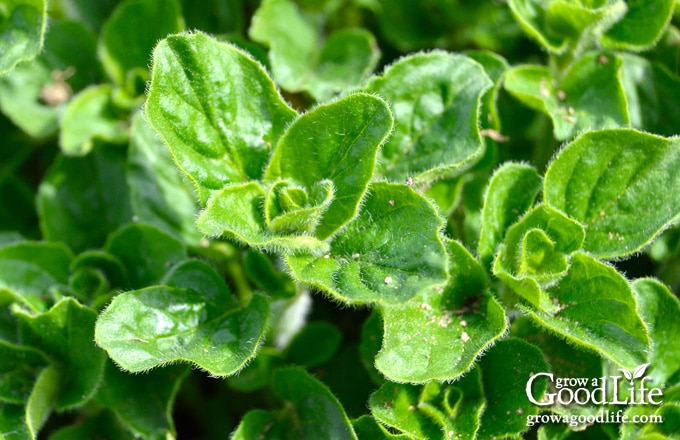
Parsley
Italian, Flat Leaf Parsley (Petroselinum crispum) is a biennial herb and can live up to two years indoors. Parsley is often used as a garnish and pairs well many foods such as, meats, salads, soups, and roasts. Curly parsley (Petroselinum crispun var. crispum) is used mostly as a garnish, but also has lots of flavor.
Tips for Growing Parsley Indoors:
- Sunlight: Full sun to partial shade, about 4-6 hours per day
- Room Temperature: Cooler temperatures, between 60-70˚F
- Potting Mix: All-purpose soilless potting mix
- Watering: Twice a week when the soil surface feels dry. Water regularly and do not allow the plants to dry out completely.
- How to Grow: Start from seed or plants. Parsley has a long taproot. Plant in at least a 12-inch deep container. Parsley is very slow to grow from seeds. Purchase plant starts for faster harvest. Also see How to Grow Parsley for additional growing information.
- Harvest: Once the plant is established, harvest by snipping outer stalks from the base of the plant and trim off leaves as needed. Freeze stalks and use in making stalks and broths.
Rosemary
Rosemary (Rosmarinus officinalis) is a shrub herb with short, needle leaves that have lots of flavor. Rosemary pairs well with many dishes, including chicken, pork, tomato sauce, soups, and roasts.
Tips for Growing Rosemary Indoors:
- Sunlight: Full sun, at least 6 hours per day
- Room Temperature: Cooler temperatures, between 60-70˚F
- Potting Mix: Well-drained, sandy soil mix. Mix equal parts all-purpose potting mix and sharp sand. Or use cactus-potting mix.
- Watering: Once a week when the soil surface feels dry. Allow top few inches of soil to dry out between waterings then water thoroughly. Rosemary likes to stay on the dry side.
- How to Grow: Start from seed, plants, or cuttings.
- Rosemary can be difficult to keep alive over the winter month due to the lack of humidity in the air. Rosemary draws in moisture from the air with its foliage, and prefers the roots to be rather dry. Increase humidity around the plant by setting the container on a large saucer of stones and keep the saucer filled with water. Rosemary grows slowly, so you may wish to keep several plants.
- Harvest: Once the plant is at least 6-inches, begin cutting sprigs as needed for meals.
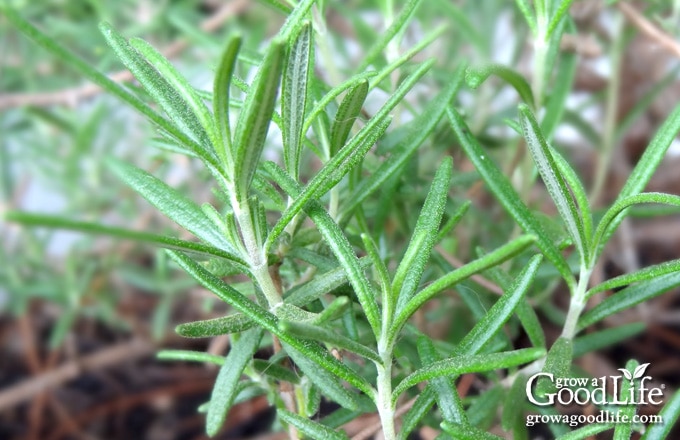
Sage
Sage (Salvia ssp) is a family of perennial shrubby herbs with rounded leaves. Some varieties are much larger than others. Seek out a compact type to grow indoors so it doesn’t overwhelm your windowsill. It has a savory, slightly peppery flavor that compliments sausage, stuffing, pork, poultry, and vegetables.
Tips for Growing Sage Indoors:
- Sunlight: Full sun, at least 6 hours per day
- Room Temperature: Cooler temperatures, between 60-70˚F
- Potting Mix: Well-drained, sandy soil mix. Mix equal parts all-purpose potting mix and sharp sand. Or use cactus-potting mix.
- Watering: Once a week when the soil surface feels dry. Allow top few inches of soil to dry out between waterings then water thoroughly.
- How to Grow: Start from seed, plants, or cuttings. Sage is a perennial herb and can be planted in your herb garden when it becomes too large to grow in containers. Sage will come back each year in growing zones 5-8.
- Harvest: Once the plant is established, harvest leaves as needed for meals.
Sweet Bay Tree
Sweet bay laurel (Laurus nobilis) is an evergreen tree that produces thick flavorful foliage. The leaves pair well with fish, meat, and poultry dishes. Add to roasts, simmering sauces, soups, and stews. Remove the leave before serving.
Tips for Growing Bay Laurel Indoors:
- Sunlight: Full sun to partial shade, about 4-6 hours per day
- Room Temperature: Cooler to average temperatures, between 60-75˚F
- Potting Mix: Well-drained, sandy soil mix. Mix equal parts all-purpose potting mix and sharp sand. Or use cactus-potting mix.
- Watering: Once a week or when the soil surface feels dry.
- How to Grow: Start from purchased plant. Bay laurel takes a long time growing from seed and is difficult to propagate through cuttings. You’ll have quicker results starting with a plant from your local nursery. Plant in a generous sized container that will contain the current root ball and allow the plant to grow. You will need to pot up sweet bay often when the roots fill the container. Over time, sweet bay will grow to a small tree size even indoors. Prune to keep the plant compact. Under sufficient growing conditions, bay laurel plants can grow for many years in containers.
- Harvest: Begin harvesting leaves sparingly from young plants. The oldest leaves have the strongest flavor. Pick individual leaves as needed for meals.
Sweet Marjoram
Sweet Marjoram (Origanum majorana) is grown mostly as an annual. Marjoram has a slightly sweet, floral, lightly spiced fragrance. It’s like a delicate version of oregano of which it is related. Marjoram is best used at the end of cooking to preserve its flavor. Also use the leaves fresh in salad dressings and marinades.
Tips for Growing Marjoram Indoors:
- Sunlight: Full sun, at least 6 hours per day
- Room Temperature: Cooler temperatures, between 60-70˚F
- Potting Mix: Well-drained, sandy soil mix. Mix equal parts all-purpose potting mix and sharp sand. Or use cactus-potting mix.
- Watering: Once or twice a week when the soil surface feels dry.
- How to Grow: Start from seed, plants, or cuttings. Trim the plant back after it blooms and it will produce new growth.
- Harvest: Once the plant is 6-inches tall, begin cutting stems as needed throughout the growing season. Strip the leaves from the woody stems and use in your favorite recipes. Harvest before the plant blooms for the strongest flavor.
Thyme
Common Thyme (Thymus vulgaris) is a perennial herb that grows as a woody shrub with small, oval leaves on long stems. The savory flavor of thyme complements most meats, including chicken, beef, pork, and game. I use thyme in winter in crockpot stews and roast.
Tips for Growing Thyme Indoors:
- Sunlight: Full sun, at least 6 hours per day
- Room Temperature: Cooler temperatures, between 60-70˚F
- Potting Mix: Well-drained, sandy soil mix. Mix equal parts all-purpose potting mix and sharp sand. Or use cactus-potting mix.
- Watering: Once or twice a week when the soil surface feels dry.
- How to Grow: Start from seed, plants, or cuttings. Also see How to Grow Thyme for additional information.
- Harvest: Once the plant is 6-inches tall, begin cut stems as needed throughout the growing season. Strip the leaves from the stems and use in your favorite recipes. Harvest before the plant blooms for the strongest flavor.
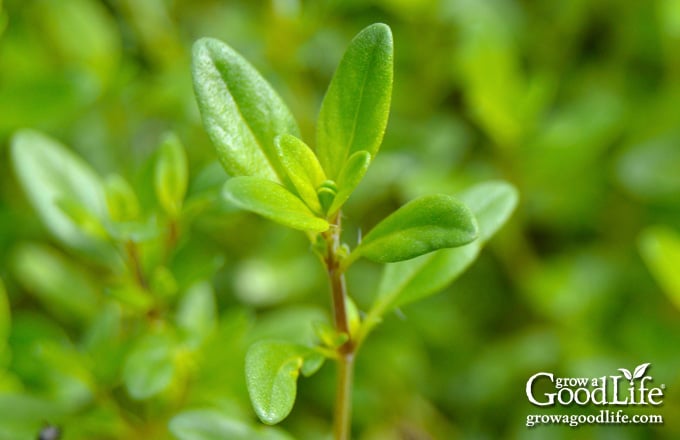
—
I hope I have encouraged you to try growing herbs indoors. Begin with one or two of your favorite herbs and see how it goes.
This article was originally published on September 30, 2014. It has been updated with additional information and photos.
You May Also Like:
- 7 Herbs to Start from Seed
- How to Harvest and Dry Herbs for Storage
- How to Grow an Indoor Garden
- 10 Reasons to Grow Your Own Organic Food
Good planning is key to a successful vegetable garden
Whether you are new to growing your own food or have been growing a vegetable garden for years, you will benefit from some planning each year. You will find everything you need to organize and plan your vegetable garden in my PDF eBook, Grow a Good Life Guide to Planning Your Vegetable Garden.


Thank you thank you for sharing this information. It’s what I have been looking for on one page 🤗🤗🤗
Hi Rachel,
Thank you for the great information. I have rosemary plant growing indoors and I seeded basil for winter as well. I always wondered what is the best way to harvest these herbs whenever you need for cooking. Is it better to just pick the leaves or cut with the stems so it lasts longer?
Thank you,
Aga
Aga, Rosemary can be harvested by cutting the stems as needed, and then strip the leaves from the stem and chop for cooking. New growth will sprout and form branches from the stem after it is cut.
Harvest basil from the top down. Snip the stems right above a pari of leaves. Two new stems will sprout where the leaves attach to the stem. Basil is sensitive to cold. Try to keep the plant away from drafts and cold windowsills. You can find more tips for growing basil here: https://growagoodlife.com/grow-basil/